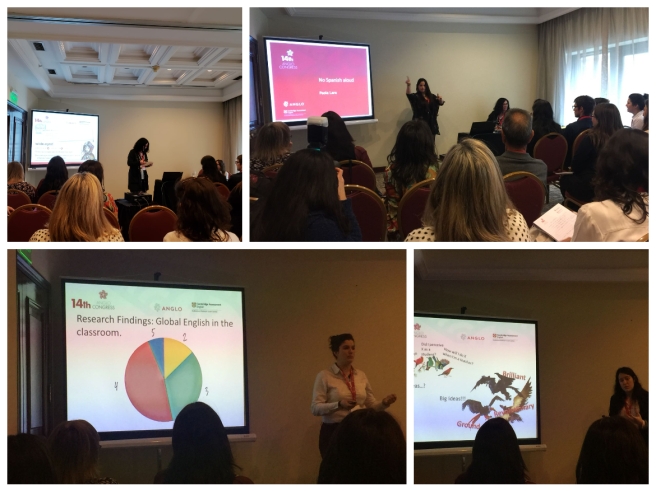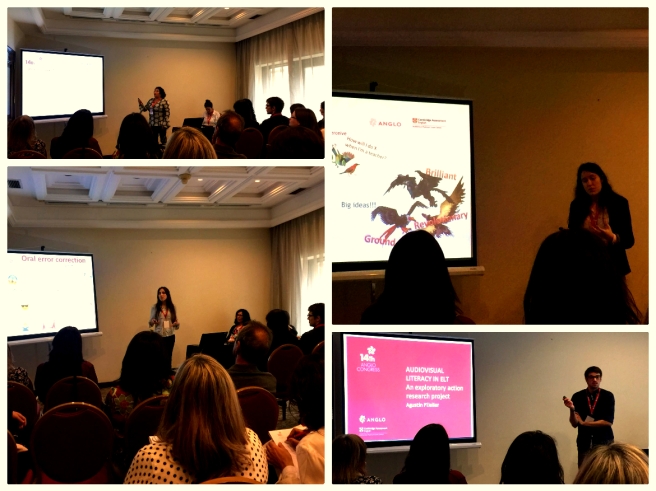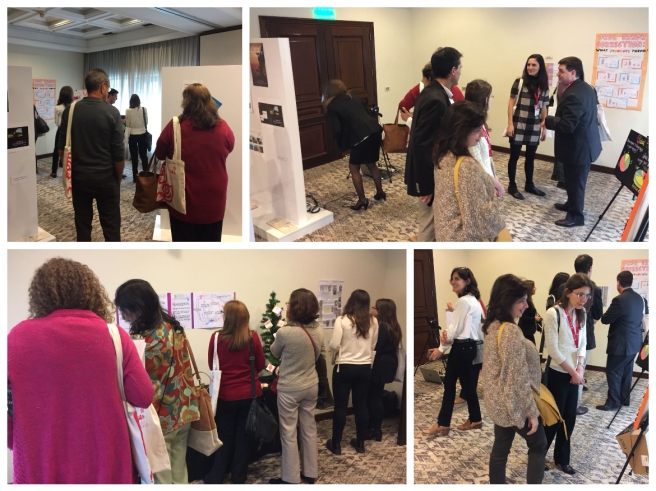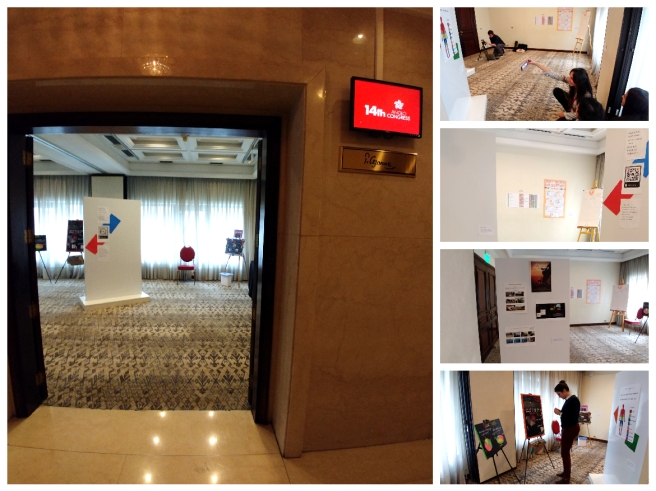You can download the presentation from this link
But… what about STUDENTS’ expectations? Teenage and adult students’ expectations and attitudes towards oral error correction in the English classroom.
Valentina Hernández
This study examined teenage and adult EFL students’ expectations and attitudes towards oral error correction at Anglo Institute and the differences between the expectations and attitudes of both age groups. Data were collected through a questionnaire which included four point-Likert-scales, options to choose, and two instances for participants to comment. It was administered to seventy-seven students of different levels. Quantitative data was organised into graphs and colour codes were created for the qualitative data analysis. The findings indicated that students expect correction of their oral errors and have a positive attitude towards it. They see oral error correction as a highly important part of their learning process and value it as an instance to improve on their command of the language. Even participants who experience embarrassment and/or frustration when corrected, expect correction. Among other findings are students’ positive attitudes towards unobtrusive techniques in which the teacher provides the correct form or a clue to it, their varied attitudes towards peer correction, and pronunciation as the area in which they seem to want correction less often. Results also suggest that age is not a main determining factor in students’ expectations and attitudes since differences were minor and only in some areas.
References
- (2017, April). Delayed Correction. British Council. Retrieved from https://www.teachingenglish.org.uk/article/delayed-correction (January 10th, 2018)
- Almari, B. & Fawizi, H. ().Students’ Preferences and Attitude toward Oral Error Correction Techniques at Yanbu University College, Saudi Arabia. English Language Teaching, 9 (11), 59-66.
- Baran-Lucarz, M. (2013). Phonetics Learning- Results of a Preliminary Study. Research in Language, 11 (1), 57-79.
- Brown, A. (2014). Pronunciation and Phonetics: A Practical Guide for English Teachers. Retrieved from https://books.google.com.uy/books?id=FEosAwAAQBAJ&pg=PT218&lpg=PT218&dq=pronunciation+embarrassment+for+learners&source=bl&ots=BusdGjc1-i&sig=BXCNCz-4sSGoCOD_LqkHubee5lo&hl=es&sa=X&ved=0ahUKEwiepd26iPbYAhWDkpAKHZ90AdoQ6AEITDAG#v=onepage&q=pronunciation%20embarrassment%20for%20learners&f=false (February 8th, 2018)
- Cherry, K. (2017). Attitudes and Behavior in Psychology. Verywellmind. Retrieved from https://www.verywellmind.com/attitudes-how-they-form-change-shape-behavior-2795897 (February 8th, 2018)
- Coskun, A. (2010). A Classroom Research Study on Oral Error Correction. Humanizing Language Teaching Magazine, 12 (3), 1-12.
- Dardanelli, E. (2012). Oral Correction in the Classroom: Context and teachers’ awareness (Research Project). Instituto Cultural Anglo Uruguayo, Montevideo, Uruguay.
- (2018). Collins English Dictionary. Retrieved 10 January 2018, from https://www.collinsdictionary.com/dictionary/english/expectation
- (n.d). Retrieved on January 10th,, 2018, from http://psychology.iresearchnet.com/social-psychology/social-cognition/expectations/
- Hendrickson, J. (1978). Error Correction in Foreign Language Teaching: Recent Theory, Research, and Practice. The Modern Language Journal, 62 (8), 387-398.
- Katayama, A. (2007). Learners’ perceptions toward oral error correction. In K. Bradford-Watts (Ed.), JALT2006 Conference Proceedings. Tokyo: JALT.
- Katayama, A. (2007). Students Perceptions of Oral Error Correction. Japanese Language and Literature, 41, 61-92.
- Loewen, S. (2007). Error correction in the second language classroom. Clear News, 11 (2), 1-7.
- Lyster, R. & Ranta, L. (1997). Corrective feedback and learner uptake: Negotiation of form in communicative classrooms. Studies in Second Language Acquisition, 20, 37-66.
- Papangkorn, P. (2015). SSRUIC Students’ Attitude And Preference Toward Error Corrections. Procedia: Social and Behavioral Science, 197, 1841-1846.
- Smith, H. (2010). Correct me if I’m wrong: Investigating the preferences in error correction among adult English language learners (Master’s Thesis). The University of Central Florida, Orlando, Florida.
- Silling, K. (2013). Learn-in: Subsídios para professores de inglês – Oral error correction treatment in communicative language teaching. Sao Paulo: APLIESP.
- Sultuna, A. (2009) Peer correction in ESL classroom. BRAC University Journal,6 (1), pp. 11-19.
- Thornbury, S. (2006). An A-Z of ELT. Oxford, UK: Macmillan education.
- Underhill, A. (2012) Pronunciation and Embarrassment. Adrian Underhill Pronunciation Site. Retrieved from http://www.adrianunderhill.com/2012/12/06/pronunciation-and-embarrassment/
Valentina Hernández has just got her Anglo Diploma in TEFL. She is a Ceibal teacher and teaches children, teenagers and adults at Anglo. She also teaches one-to-one lessons and is an advanced Psychology student at UDELAR.
“No Spanish aloud” – Motivating students to speak English in class at intermediate levels
Paola Lara
The aim of this exploratory action research project was to encourage students to communicate in English in class since the use of students’ own language was inadequate taking into account their level: B1 and B1+ (B1 and B1+ Refer to the level of competence according to the Common European Framework). Through a series of activities that I explored during class in order to promote oral communication, students developed better speaking skills. Bearing in mind the negative feelings learners expressed towards oral activities, I carried out tasks that could lower anxiety and develop their confidence. This was accomplished through testing such activities, investigating students’ likes and dislikes, and taking advantage of learners’ output that led to further oral practice. All data were collected through classrooms activities, and a series of suggestions for the practitioner are provided.
References
- Allwright, D. (2003, April 1). Exploratory Practice: Rethinking practitioner research in language teaching. Language Teaching Research, 7(2), 113-141.
- Bentley, K. (2010). The TKT Course CLIL Module. (C. U. Press, Ed.) Cambridge.
- Bruner, J., Ross, G., & Wood, D. (1976, April). The role of tutoring in problem-solving*. The Journal of Child Psychology and Psychiatry, 17(2), 89-100.
- Cook, V. (2001, March). Using the First Language in the Classroom. Canadian Modern Language Review, 57(3), 402-423.
- Goldstein, T. (2003). Teaching and learning in a multilingual school: choices, risks, and dilemmas.
- Krashen, S. (1982, April 26). Some issues relating to the monitor model. (Pergamon, Ed.) California: University of Southern California.
- Roach, P. (1991). English Phonetics and Phonology: A Practical Course. Second Edition. Cambridge: Cambridge UP.
- Scrivener, J. (2005). Learning Teaching: A guidebook for English language teachers (2nd ed.). Oxford: Macmillan.
- Seligson, P. (2003). Advantaging Brazilian Learners. Plenary delivered at the 2nd Alumni, CTJ, and Ibeu TEFL Conference.
- Swain, M. (1995). Three functions of output in second language learning. (G. Cook, & S. Barbra, Eds.) Oxford University Press, Principle and practice in applied linguistics, 125-144.
- Underhill, A. (2005). Sound Foundation: Learning and Teaching Pronunciation. Oxford: Macmillan.
Paola Lara has proudly completed her TTC this year and She has been working as an English teacher for 10 years at Lennon Institute, her classes vary in different levels and ages. She has also studied acting, singing, and dancing which she usually incorporates in her classes.
Global English: From theory to the classroom. Where do we stand in the conversation?
Elisa Díaz
This study analysed teachers’ thoughts and attitudes towards World Englishes, or the different varieties of English that can be found around the world, together with the concept of Global English and its inclusion in their lessons among a random group of Anglo teachers. The findings indicate that most teachers believe Global English to be fairly relevant and worthy of inclusion in their lessons, with some even stating that they had already incorporated it to various extents. However, in the answers regarding the different varieties of English including questions such as which varieties do you expose students to regularly?, the vast majority of the results pointed to British English and American English, with very few exceptions. This seems to indicate that Global English is in fact not very present in the lessons, or at least not as present as the answers to the section regarding Global English suggested. All things considered, further research into how to incorporate this concept would be fitting.
References
- Young, T., Walsh, S., & Schartner, A. (2016). Which English? Whose English? Teachers’ beliefs, attitudes and practices (Rep.). doi:978-0-86355-839-9
- Crystal, D. (2010). Should English be taught as a ‘global’ language? [Video file]. (2010, April 18). Retrieved from https://youtu.be/tLYk4vKBdUo
- Crystal, D. (2003). English as a global language. 2nd ed. Cambridge University Press, pp.59-61.
- Seidlhofer, B. (2011). Understanding English as a lingua franca. Oxford: Oxford University Press.
- Jenkins, J. (2000). The Phonology of English as an International Language. Oxford University Press.
- Jenkins, J. (2007). English as a Lingua Franca: Attitude and Identity. Oxford University Press.
- International English: What are our students learning? – British Council, Italy (2010) [Video file]. (2011, October 13). Retrieved from https://youtu.be/hbfxJQvy0Xk “To begin with, English is an international language. -J. R. Firth 1956”
- Richardson, S. (2016). Plenary by Silvana Richardson IATEFL.
- Latham Koenig, C., Oxenden, C. and Seligson, P. (2012). English File Elementary Teacher’s Book. 3rd ed. Oxford: Oxford University Press, p.28.
Elisa Díaz has just graduated from the Anglo Diploma in TEFL and is working at Anglo as a teacher for a variety of levels. She also studies Fonoaudiología at UDELAR.
Coaching and One-to-one lessons
Alejandra Gretter
Coaching Sessions and One-to-One lessons are two kinds of lessons that have gained importance in the last few years. This paper aims to give a comprehensible account of the possible differences and similarities of the two lessons, the skills needed by teachers teaching these lessons, the scaffolding involved and the role of assessment in both. In this interview research project, I intended to report on the personal experiences of Anglo Teachers involved in these types of lessons. The data were gathered by conducting interviews with such teachers and analysed using qualitative methods. The data obtained are broadly consistent and clear, from which differences and similarities, as well as the skills needed by teachers, were charted.
References
Alejandra Gretter has just finished the Anglo Teacher Training Course but has been teaching one-to-one and coaching lessons for over 27 years. She is an Anglo teacher of children, teenagers and adults. She also holds a diploma in Administration from UTU.
Audiovisual literacy in ELT
Agustín Flieller
Globalization has contributed to the massive sharing of narratives and language worldwide. At the same time, there are stories which are omitted due to the fact that production and distribution are highly controlled. The capacity to produce their own pieces allows citizens to understand the film industry and contribute, from diverse perspectives to the creation and distribution from within the audiovisual culture. If the ultimate goal of traditional literacy is to learn to read and write a certain alphabet or language, audiovisual literacy aims at acquiring the capacity to watch and produce audiovisual work, whichever genre the citizens (in these case learners) need or want to create in collaborative group work. This study was conducted under the framework of exploratory action research in a group of young learners of English as a foreign language to evaluate the impact of audiovisual literacy on teaching.
References
- Avison D Baskerville R & Myers M (2001) ‘Controlling action research projects’ Information Technology & People, Vol. 14 No. 1, 2001, pp. 28-45.
- Aguaded-Gomez, I., & Perez-Rodriguez, M. (2012). Strategies for media literacy: Audiovisual skills and the citizenship in Andalusia. Journal Of New Approaches In Educational Research, 1(1). http://dx.doi.org/10.7821/naer.1.1.22-26.
- Bloom, B., Krathwohl, D., & Masia, B. (1956). Taxonomy of educational objectives. New York: D. McKay.
- Burns, A. and Richards, J. (2012). The Cambridge guide to pedagogy and practice in second language teaching. Cambridge University Press.
- Carroll, L. (1961). Alice in Wonderland. London: J.M. Dent & Sons.
- Castells, M. (1999). Critical education in the new information age. Lanham: Rowman & Littlefield.
- Crystal, D. (2003). English as a global language. 2nd ed. Cambridge University Press.
- de la Torre, S., Rajadell i Puiggròs, N., Tejada Fernández, J., Violant, V., Oliver, C., & Girona, M. (2004). El cine como estrategia didáctica innovadora. Metodología de estudio de casos y perfil de estrategias docentes. Contextos Educativos. Revista De Educación, 0(6), 65. http://dx.doi.org/10.18172/con.529
- Eco, U. (1989). The open work. Cambridge: Harvard University Press.
- Flusser, V. (2011). Into the universe of technical images. Minneapolis: University of Minnesota Press.
- Goldstein, B. (2016). Visual literacy in English language teaching: Part of the Cambridge Papers in ELT series. [pdf] Cambridge: Cambridge University Press.
- Goldstein, B. and Thornbury, S. (2009). Working with images. Cambridge: Cambridge University Press.
- González García, M. (2015). Cine y literatura para el aprendizaje de las competencias básicas: vínculos semióticos y educativos. Educatio Siglo XXI, 33(1), 175. http://dx.doi.org/10.6018/j/222551.
- Harvey, S. (1978). May ’68 and film culture. London: BFI.
- Knowles, M., Holton, E. and Swanson, R. (2010). The Adult Learner. 6th ed. Amsterdam [etc.]: Elsevier, pp.35-73.
- Luna, M. (2008). Audiovisual education to promote multiple competences. Comunicar, 16 (31). http://dx.doi.org/10.3916/c31-2008-03-037
- Mackay, B. (2010). Family and friends. Oxford: Oxford University Press.
- Manvell, R. (1955). The film and the public. Harmondsworth: Penguin Books.
- Marfil-Carmona, R., & Chacón, P. (2017). Arts Education and Media Literacy in the Primary Education Teaching Degree of the University of Granada. Procedia – Social And Behavioral Sciences, 237, 1166-1172. http://dx.doi.org/10.1016/j.sbspro.2017.02.174
- McLuhan, M. (1964). Understanding media. Toronto: Toronto Education Quarterly.
- Perković, A., & Rigo, I. (2010). Film as an English teaching tool at tertiary education level. srce.hr. Retrieved 13 February 2018, from https://hrcak.srce.hr/63969
- Simmons, N. (2014). Family and friends. Oxford university press.
Agustín Flieller is about to obtain his Diploma in TEFL. He teaches English in primary school, institute context for junior levels and UTEC. He collaborates with the well-known film-maker Mario Handler in a course on documentary films at UDELAR, where he is also doing a Masters Degree in information and communication.
The relationship between motivation, time management and academic achievement: a personal quest.
Josefina Lussich
My learning process as a teacher has allowed me to reflect upon my experiences as a student. As a result, I became curious about how certain aspects that influence learning (time management and motivation) interact with each other and have an impact on academic performance at the same time. By using secondary research, I gathered a number of studies which touched upon the subject. I compared the definitions and the results, and compared them to the perceptions I had as a teacher and as a student. These findings allowed me to reflect on my personal teaching practice. I came to the conclusion that in order to achieve better results in my lessons, I should shift my focus from the course contents towards the students’ ideas and experiences.
References
- Banditvilai, C. (2016). Enhancing Students’ Language Skills through Blended Learning. Electronic Journal of e-Learning, 220-229.
- Bensoussan, M. (2014). Motivation and English language learning in a multicultural university context. Journal of Multilingual and Multicultural Development, 423-440.
- Burrus, J., Jackson, T., Holtzman, S., & Roberts, R. D. (2016). Teaching high school students to manage time: The development of an intervention. Improving Schools, 1-12.
- Häfner, A., Oberst, V., & Stock, A. (2014). Avoiding procrastination through time management: an experimental intervention study. Educational Studies, 352-360.
- Ilieva, I. P., & Farah, M. J. (2015). Attention, Motivation, and Study Habits in Users of Unprescribed ADHD Medication. Journal of Attention Disorders, 1-14.
- Kizilcec, R.F., Pérez-Sanagustín, M., & Maldonado, J.J. (2016). Recommending Self-Regulated Learning Strategies Does Not Improve Performance in a MOOC. L@S.
- Kormos, J., & Csizér, K. (June de 2014). The Interaction of Motivation, Self-Regulatory Strategies, and Autonomous Learning Behavior in Different Learner Groups. TESOL Quarterly, 48(2), 275-299.
- Kumari, S., & Chamundeswari, S. (2015). Achievement Motivation, Study Habits and Academic Achievement of Students at the Secondary Level. International Journal of Emerging Research in Management &Technology, 7-13.
- Matrianni, T. M. (2015). When the Due Date is not the “Do” Date! Learning Communities Research and Practice.
- McEown, M., & Takeuchi, O. (2014). Motivational strategies in EFL classrooms: how do teachers impact students’ motivation? Innovation in Language Learning and Teaching, 20-38.
- Mega, C., Ronconi, L., & De Beni, R. (2014). What Makes a Good Student? How Emotions, Self-Regulated Learning, and Motivation Contribute to Academic Achievement. Journal of Educational Psychology, 106(1), 121-131.
- Ning, H. K., & Downing, K. (2010). The reciprocal relationship between motivation and self-regulation: A longitudinal study on academic performance. Learning and Individual Differences, 20(6), 682-686.
- Ocak, G., & Boyraz, S. (2016). Examination of the Relation between Academic Procrastination and Time Management Skills of Undergraduate Students in terms of Some Variables. Journal of Education and Training Studies, 76-84.
- Oga-Baldwin, W. L., Nakata, Y., Parker, P., & Ryan, R. M. (April de 2017). Motivating young language learners: A longitudinal model of self-determined motivation in elementary school foreign language classes. Contemporary Educational Psychology, 49, 140-150.
- Olowookere, E. I., Alao, A. A., Odukoya, J. A., Adekeye, O. A., & Agbude, G. (2015). Time Management Practices, Character Development and Academic Performance among University Undergraduates: Covenant University Experience. Creative Education, 79-86.
- Panek, E. (2013). Left to Their Own Devices: College Students’ ”Guilty Pleasure” Media Use and Time Management. Communication Research, 561–577.
- Seker, M. (2015). The use of self-regulation strategies by foreign language learners and its role in language achievement. Language Teaching Research, 5(20), 600-618.
- Shell, M. (2016). A comparative study of students’ motivation for learning English as a foreign language and their preferences for instructional strategies in Grades 9-12 at Pan-Asia International School, Bangkok, Thailand. (Master’s thesis, Assumption University, Bangkok). Retrieved from: http://repository.au.edu/handle/6623004553/19508
- Shen, B., McCaughtry, N., Martin, J., Garn, A., Kulik, N., & Fahlman, M. (2015). The relationship between teacher burnout and student motivation. British Journal of Educational Psychology, 519-532.
- Struthers, C. W., Perry, R. P., & Menec, V. H. (2000). An examination of the relationship among academic stress, coping, motivation and performance in college. Research in Higher Education, 581-592.
- Thibodeaux, J., Deutsch, A., Kitsantas, A., & Winsler, A. (2016). First-Year College Students’ Time Use: Relations With Self-Regulation and GPA. Journal of Advanced Academics, 28(1), 5-27.
- Torenbeek, M., Jansen, E., & Suhre, C. (2013). Predicting undergraduates’ academic achievement: the role of the. Studies in Higher Education, 38(9), 1393-1406.
- Tsai, H.-C., & Liu, S.-H. (2015). Relationships between time-management skills, Facebook interpersonal skills and academic achievement among junior high school students. Social Psychology of Education, 503-516.
- Wang, J., Sperling, R. A., & Haspel, P. (2015). Patterns of Procrastination, Motivation, and Strategy Use across Class Contexts and Students’ Abilities. Journal of Psychology and Behavioral Science, 3(2), 61-73.
- Yang, X., Xu, X., & Zhu, L. (2015). Media multitasking and psychological well-being in Chinese adolescents: Time management as a moderator. Computers in Human Behavior, 216-222.
- Zhang, Y., Lin, C.-H., Zhang, D., & Choi, Y. (2016). Motivation, strategy, and English as a foreign language vocabulary learning: A structural equation modelling study. British Journal of Educational Psychology, 87(1), 57-74.
Josefina Lussich has just got hold of her Anglo Diploma in TEFL but has been teaching at Anglo since last year. She is an IB Diploma graduate. She works as a Literature in English teacher at St. Brendan’s School. She also studies Psychology at UDELAR.
(The Arts), Teacher Research and Teacher Autonomy
Some useful links:
Benson, P. (2012). Autonomy in Language Learning, Learning and Life. [online] Gerflint.fr. Available at: https://gerflint.fr/Base/France9/benson.pdf [Accessed 10 Aug. 2018].
Benson, P. (2006). Autonomy in language teaching and learning. [online] Pucsp.br. Available at: http://www.pucsp.br/inpla/benson_artigo.pdf [Accessed 10 Aug. 2018].
CAKIR, A., & Balcikanli, c. (2012). The Use of the EPOSTL to Foster Teacher Autonomy: ELT Student Teachers’ and Teacher Trainers’ Views. Australian Journal of Teacher Education, 37(3). http://dx.doi.org/10.14221/ajte.2012v37n3.7
Eisner, E. (2003). The Arts and the Creation of Mind. Retrieved from https://acurriculumjourney.files.wordpress.com/2014/04/eisner-2003-the-arts-and-the-creation-of-mind.pdf
Gremmo, M. and Riley, P. (1995). [online] People.exeter.ac.uk. Available at: http://people.exeter.ac.uk/zhhm201/1-s2.0-0346251X95000022-main.pdf [Accessed 8 Aug. 2018].
Smith, R. Teacher education for teacher-learner autonomy. Retrieved from http://homepages.warwick.ac.uk/~elsdr/Teacher_autonomy.pdf
Rossana Piccini is an Anglo teacher and the ‘Introduction to Research Methods’ tutor at the Anglo Diploma in TEFL. She is also a Cambridge English Speaking Examiner and Team Leader and holds a degree in Arts from UDELAR












